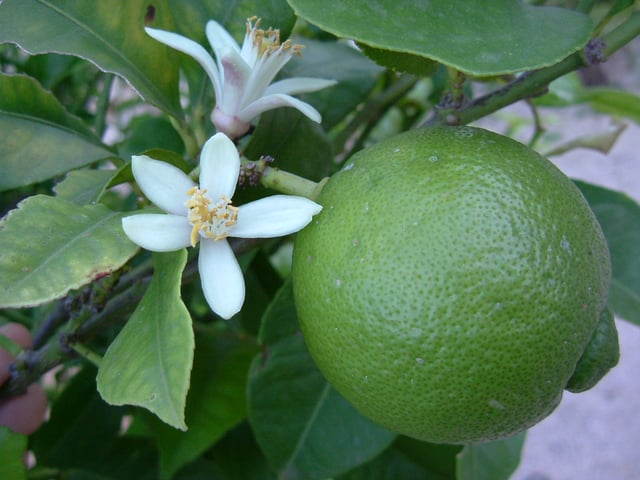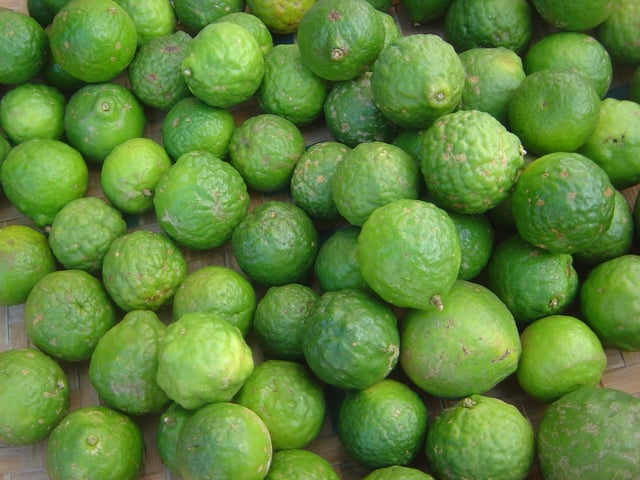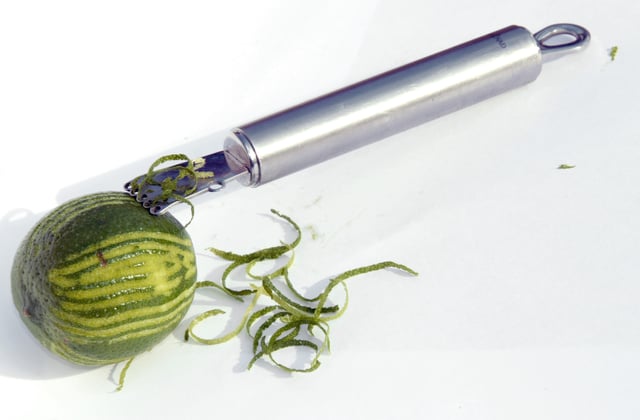Lime (fruit)
-HiMF3r1rI27bwhgkBPXYBGtSRIfiFh)
Lime (fruit)
-HiMF3r1rI27bwhgkBPXYBGtSRIfiFh)
| Nutritional value per 100 g (3.5 oz) | |
|---|---|
| Energy | 126 kJ (30 kcal) |
10.5 g | |
| Sugars | 1.7 g |
| Dietary fiber | 2.8 g |
Fat | 0.2 g |
Protein | 0.7 g |
| Vitamins | Quantity%DV† |
| Thiamine (B1) | 3% 0.03 mg |
| Riboflavin (B2) | 2% 0.02 mg |
| Niacin (B3) | 1% 0.2 mg |
| Pantothenic acid (B5) | 4% 0.217 mg |
| Vitamin B6 | 4% 0.046 mg |
| Folate (B9) | 2% 8 μg |
| Vitamin C | 35% 29.1 mg |
| Minerals | Quantity%DV† |
| Calcium | 3% 33 mg |
| Iron | 5% 0.6 mg |
| Magnesium | 2% 6 mg |
| Phosphorus | 3% 18 mg |
| Potassium | 2% 102 mg |
| Sodium | 0% 2 mg |
| Other constituents | Quantity |
| Water | 88.3 g |
Full Link to USDA Database entry [25] | |
| |
| †Percentages are roughly approximated using US recommendations for adults. Source: USDA Nutrient Database [26] | |

Lime and blossom

Kaffir lime fruit

Zesting a lime

Lime (Citrus latifolia) essential oil
There are several species of citrus trees whose fruits are called limes, including the Key lime (Citrus aurantifolia), Persian lime, kaffir lime, and desert lime. Limes are a rich source of vitamin C, are sour, and are often used to accent the flavours of foods and beverages. They are grown year-round.[3] Plants with fruit called "limes" have diverse genetic origins; limes do not form a monophyletic group.
| Nutritional value per 100 g (3.5 oz) | |
|---|---|
| Energy | 126 kJ (30 kcal) |
10.5 g | |
| Sugars | 1.7 g |
| Dietary fiber | 2.8 g |
Fat | 0.2 g |
Protein | 0.7 g |
| Vitamins | Quantity%DV† |
| Thiamine (B1) | 3% 0.03 mg |
| Riboflavin (B2) | 2% 0.02 mg |
| Niacin (B3) | 1% 0.2 mg |
| Pantothenic acid (B5) | 4% 0.217 mg |
| Vitamin B6 | 4% 0.046 mg |
| Folate (B9) | 2% 8 μg |
| Vitamin C | 35% 29.1 mg |
| Minerals | Quantity%DV† |
| Calcium | 3% 33 mg |
| Iron | 5% 0.6 mg |
| Magnesium | 2% 6 mg |
| Phosphorus | 3% 18 mg |
| Potassium | 2% 102 mg |
| Sodium | 0% 2 mg |
| Other constituents | Quantity |
| Water | 88.3 g |
Full Link to USDA Database entry [25] | |
| |
| †Percentages are roughly approximated using US recommendations for adults. Source: USDA Nutrient Database [26] | |
Plants known as "lime"
The difficulty in identifying exactly which species of fruit are called lime in different parts of the English-speaking world (and the same problem applies to homonyms in other European languages) is increased by the botanical complexity of the citrus genus itself, to which the majority of limes belong. Species of this genus hybridise readily, and it is only recently that genetic studies have started to throw light on the structure of the genus. The majority of cultivated species are in reality hybrids, produced from the citron (Citrus medica), the mandarin orange (Citrus reticulata), the pomelo (Citrus maxima) and in particular with many lime varieties, the micrantha (Citrus micrantha).
Australian limes (former Microcitrus and Eremocitrus) Australian desert lime (Citrus glauca) Australian finger lime (Citrus australasica) Australian lime (Citrus australis) Blood lime (red finger lime × (sweet orange × mandarin) )
Kaffir lime (Citrus hystrix); a papeda relative, is one of three most widely produced limes globally.[4]
Key lime (Citrus × aurantifolia=Citrus micrantha × Citrus medica[5][6][7]) is also one of three most widely produced limes globally.[4]
Musk lime (calamondin, Citrofortunella mitis), a kumquat × mandarin hybrid
Persian lime (Citrus × latifolia) a key lime × lemon hybrid, is the single most widely produced lime globally, with Mexico being the largest producer.[4]
Rangpur lime (Mandarin lime, lemandarin,[8] Citrus limonia), a mandarin orange × citron hybrid
Spanish lime (Melicoccus bijugatus); not a citrus
Sweet lime etc. (Citrus limetta, etc.); several distinct citrus hybrids
Wild lime (Adelia ricinella); not a citrus
Wild lime (Zanthoxylum fagara); not a citrus
Limequat (lime × kumquat)
Note that the tree species known in Britain as lime trees (Tilia sp.), called linden in other dialects of English, are broadleaf temperate plants unrelated to the citrus fruits.
History
| Lemon and lime production – 2016 | |
|---|---|
| Country | Production (millions of tonnes) |
3.0 | |
2.4 | |
2.3 | |
1.7 | |
1.3 | |
World | 17.3 |
Source: FAOSTAT of the United Nations[9] | |
Although the precise origin is uncertain, wild limes are believed to have first grown in Indonesia or Southeast Asia, and then were transported to the Mediterranean region and north Africa around 1000 CE.[2]
To prevent scurvy during the 19th century, British sailors were issued a daily allowance of citrus, such as lemon, and later switched to lime.[10] The use of citrus was initially a closely guarded military secret, as scurvy was a common scourge of various national navies, and the ability to remain at sea for lengthy periods without contracting the disorder was a huge benefit for the military. British sailors thus acquired the nickname "Limey" because of their use of limes.[11]
The Lime Panic of 2014 saw a massive increase in lime prices due to a perfect storm of strong weather in Mexico that destroyed many blossoms on like trees, and Mexican cartels that hijacked like transport trucks and warehouses for financial gain.
Production
In 2016, global production of lemons and limes was 17.3 million tonnes, led by India with 17% of the world total (table). Mexico and China were other major producers.
Uses
Limes have higher contents of sugars and acids than lemons do.[2] Lime juice may be squeezed from fresh limes, or purchased in bottles in both unsweetened and sweetened varieties. Lime juice is used to make limeade, and as an ingredient (typically as sour mix) in many cocktails.
Lime pickles are an integral part of Indian cuisine. South Indian cuisine is heavily based on lime; having either lemon pickle or lime pickle is considered an essential of Onam Sadhya.
In cooking, lime is valued both for the acidity of its juice and the floral aroma of its zest. It is a common ingredient in authentic Mexican, Vietnamese and Thai dishes. Lime soup is a traditional dish from the Mexican state of Yucatan. It is also used for its pickling properties in ceviche. Some guacamole recipes call for lime juice.
The use of dried limes (called black lime or loomi) as a flavouring is typical of Persian cuisine and Iraqi cuisine, as well as in Persian Gulf-style baharat (a spice mixture that is also called kabsa or kebsa).
Lime is an ingredient of many cuisines from India, and many varieties of pickles are made, e.g. sweetened lime pickle, salted pickle, and lime chutney.
Key lime gives the character flavoring to the American dessert known as Key lime pie. In Australia, desert lime is used for making marmalade.
Lime is an ingredient in several highball cocktails, often based on gin, such as gin and tonic, the gimlet and the Rickey. Freshly squeezed lime juice is also considered a key ingredient in margaritas, although sometimes lemon juice is substituted.
Lime extracts and lime essential oils are frequently used in perfumes, cleaning products, and aromatherapy.
Nutrition and phytochemicals
Raw limes are 88% water, 10% carbohydrates and less than 1% each of fat and protein (table). Only vitamin C content at 35% of the Daily Value (DV) per 100 g serving is significant for nutrition, with other nutrients present in low DV amounts (table). Lime juice contains slightly less citric acid than lemon juice (about 47 g/l), nearly twice the citric acid of grapefruit juice, and about five times the amount of citric acid found in orange juice.[12]
Toxicity
Contact with lime peel or lime juice followed by exposure to ultraviolet light may lead to phytophotodermatitis,[15][16][17] which is sometimes called margarita photodermatitis[18][19] or lime disease[20] (not to be confused with Lyme disease). Bartenders handling limes and other citrus fruits while preparing cocktails may develop phytophotodermatitis.[21]
A class of organic chemical compounds called furanocoumarins are reported to cause phytophotodermatitis in humans.[22] Limes contain numerous furanocoumarin compounds, including limettin (also called citropten), bergapten, isopimpinellin, xanthotoxin (also called methoxsalen), and psoralen.[23][24] Bergapten appears to be the primary furanocoumarin compound responsible for lime-induced phytophotodermatitis.[23][24]
See also
Lime production in Mexico
List of citrus fruits
List of culinary fruits varieties